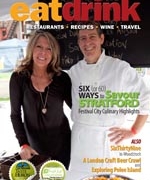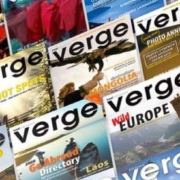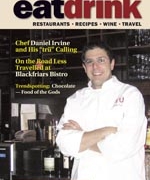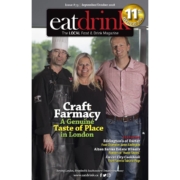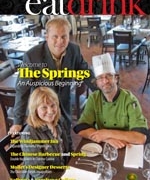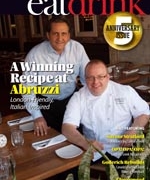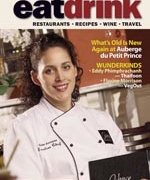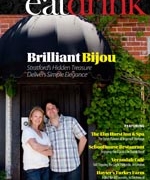The Innocent Foodies Abroad
It all starts with a determined, food-conscious bride baking her own wedding cake. From there the new book by Ann McColl Lindsay, Hungry Hearts: A Food Odyssey across Britain and Spain 1968-69, blossoms into an enjoyable account of a liberally-minded couple’s affair with food, life, and each other as they follow their whims to travel across Europe in a Volkswagen camper. Restless to take a break from their teaching careers, Ann and her husband, David Lindsay, set out to find what the world had to offer, but little did they expect such a series of food-related revelations, including a “gradual change from two innocents raised on white bread, tinned soup, and cherry cokes, to adventurous eaters, appreciative of baby eels and bouillabaisse.”
Ann is famously known for being the proprietor of Ann McColl’s Kitchen Shop in London for decades, and now she is sharing her gift for writing by eloquently retelling the moments of her life that lead to her freestyle, culinary education. The book is a collaborative artistic effort with her husband’s photography mixed in with inserts from her travel journals and over 80 personalized recipes.
Even with the recipes, this is not a conventional cookbook, because each one falls in line with a point on the map or a moment in time, rather than being arranged in more traditional themes; Ann writes, “An entire year in which every meal offered a different view was truly a moveable feast.” Like the recipe for their wedding cake (which Ann admits she still bakes from time to time), all the recipes hold personal value, several even taking a nostalgic step back to her ancestral roots in Scotland, like Mince and Tatties, Rabbit Hot Pot, and Dunoon Tomato Soup; none more meaningful though than Grandpa Grant’s Shortbread, handed down through the generations, and as Ann writes, “In the years when we operated a retail store, we distributed hundreds of grandpa Grant’s printed shortbread recipes every Christmas, along with wooden presses and fluted tin cutters.”
The number of recipes that cropped up throughout this journey is astonishing, and they continue to hold such significance to Ann and David. Given their education in the classics and visits to literary sites along the way – Canterbury where Chaucer’s Tales take place and The Old Curiosity Shop (very prophetic indeed) made famous by the fiction of Charles Dickens – it seems appropriate that Ann includes literary-themed recipes, like Jack Horner’s Plum Cake and The Queen of Hearts’ Tarts. Readers of her book are richer for being allowed access to her personal recipes, with classics such as her own take on Figgy Pudding from the Christmas carol.
Alongside the couple themselves, food takes centre stage in the book, scattered amongst a string of eclectic adventures, such as surviving ocean liner seasickness crossing the Atlantic, enduring uneventful hours on Loch Ness to spot the eponymous water monster, attending the elaborate Edinburgh Arts Festival, visiting King Arthur’s Castle, and attending a play at Cambridge university with a young Prince Charles as a cast member. It was early in their trip, in the Scottish village of Cramond that an unexpectedly delicious meal opened their eyes to “a glimpse of life beyond Spam.” Ann also had a strong premonition on Christmas Eve while enjoying Crepes Suzette that food would be a big part of her life once this trip was over.
But it wasn’t only physical nourishment they craved; the odyssey across the world, filled with literature, theatre, architecture, and history gave them inspiration for a life that lead to Ann’s future occupation. Ann writes: “Britain was a treasure trove of kitchen relics from estates and cottages waiting for me to rescue them from small secondhand stores.” As a precursor to her legacy as an independent storeowner, Ann developed a penchant for picking up kitchenware curios and assessing the failures and successes of European retailers. “In the mid-sixties, cookware was generally relegated to a few dusty shelves at the back of a hardware shop, or piled in its original cartons in the housewares section of the department stores. There was no romance to this category of merchandise” – a facet of the retail business that Ann set out to abolish by opening her own shop. Inspired by the classy British stores of Terence Conran and Elizabeth David’s Kitchen Shop, there was also an unanticipated moment of epiphany while visiting Wookey Hole Caves in England where she heard stories about rudimentary kitchen utensils on archaeological digs; a light went on for Ann as she wrote: “Here was justification for my hoard of old kitchenwares on a scientific level, more convincing than personal whimsy. We could claim to be domestic archaeologists.”
The couple’s conversion to shopping at independent stores began in Britain while visiting friendly butchers, bakers, fishmongers, and greengrocers. “These small purveyors were so pleasant, I usually preferred to turn grocery shopping into a morning’s entertainment,” Ann says. This prescient attraction to specialty shops, flea markets, tea rooms, bookshops, harbour-side fish auctions, and historic European kitchens shaped her future, and by digging into her own past, we are allowed a glimpse into the formative years of a successful local proprietor. If not for their time spent in Britain and Spain, insight for the business may not have come in the manner it did and Ann informs us that there is more inspiration to come; Hungry Hearts documents the first leg of their journey and a sequel in France and Italy will follow. Given the hearty culinary traditions in both countries, the second book will be just as tasty, as Ann leaves us hungry for more.

